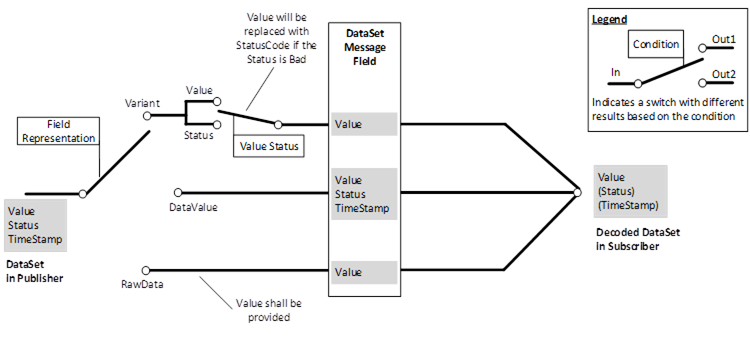A DataSet field consists of a value and related metadata. In most cases the value comes with status and timestamp information.
This DataType defines flags to include DataSet field related information like status and timestamp in addition to the value in the DataSetMessage. The parameter is not relevant for heartbeat messages but should be configured according to the header layout requirements.
The DataSetFieldContentMask is formally defined in Table 24.
The handling of bad status for different field representations is defined in Figure 23 and Table 26.
Table 24 – DataSetFieldContentMask Values
|
Value |
Bit No. |
Description |
|
DataSet fields can be represented as RawData, Variant or DataValue as described in 5.3.2. If none of the flags are set, the fields are represented as Variant. If the RawData flag is set, the fields are represented as RawData and all other bits are ignored. If one of the bits 0 to 4 is set, the fields are represented as DataValue. |
||
|
StatusCode |
0 |
The DataValue structure field StatusCode is included in the DataSetMessages. If this flag is set, the fields are represented as DataValue. |
|
SourceTimestamp |
1 |
The DataValue structure field SourceTimestamp is included in the DataSetMessages. If this flag is set, the fields are represented as DataValue. |
|
ServerTimestamp |
2 |
The DataValue structure field ServerTimestamp is included in the DataSetMessages. If this flag is set, the fields are represented as DataValue. |
|
SourcePicoSeconds |
3 |
The DataValue structure field SourcePicoSeconds is included in the DataSetMessages. If this flag is set, the fields are represented as DataValue. This flag is ignored if the SourceTimestamp flag is not set. |
|
ServerPicoSeconds |
4 |
The DataValue structure field ServerPicoSeconds is included in the DataSetMessages. If this flag is set, the fields are represented as DataValue. This flag is ignored if the ServerTimestamp flag is not set. |
|
RawData |
5 |
If this flag is set, the fields of the DataSet are encoded without additional information like timestamp, status or DataType information. The details of the representation are defined for the message mappings. All other field related flags shall be ignored if this flag is set. |
The DataSetFieldContentMask representation in the AddressSpace is defined in Table 25.
Table 25 – DataSetFieldContentMask definition
|
Attribute |
Value |
||||
|
BrowseName |
DataSetFieldContentMask |
||||
|
IsAbstract |
False |
||||
|
References |
Node Class |
BrowseName |
DataType |
TypeDefinition |
Others |
|
Subtype of UInt32 defined in OPC 10000-5 |
|||||
|
HasProperty |
Variable |
OptionSetValues |
LocalizedText [] |
PropertyType |
|
|
Conformance Units |
|||||
|
PubSub Parameters Discovery |
|||||
The DataSetFieldContentMask defines different options that influence the information flow from Publisher to Subscriber in the case of a Bad Value Status or other error situations. Figure 23 depicts the parameters and the information flow from DataSet field to DataSetMessage creation on the Publisher side and the decoded DataSet field on the Subscriber side. The DataSetFieldContentMask controls the representation of the DataSet fields in a DataSetMessage.

Figure 23 – PubSub information flow dependency to field representation
The representation of the DataSet fields in a DataSetMessage on the Publisher side and the decoding back to the DataSet fields on the Subscriber side is defined in Table 26. The representation on the Publisher side depends on the field representation defined in the DataSetFieldContentMask.
Table 26 – DataSetMessage field representation options
|
DataSet Publisher |
Field |
DataSetMessage |
DataSet Subscriber |
||||
|
Value |
Status(a) |
Value |
Value Status(a) |
Header Status |
Value |
Status(a) |
|
|
Value 1 |
Good_* |
Variant |
Value 1 |
N/A |
Good |
Value 1 |
Good |
|
Value 1 |
Uncertain_* |
Value 1 Uncertain_* (b) |
Good |
Value 1 (b) |
Uncertain_* (b) |
||
|
Null |
Bad_* |
Bad_* (c) |
Good |
Null |
Bad_* (c) |
||
|
Value 1 |
Good_* |
DataValue |
Value 1 |
Good_* |
Good |
Value 1 |
Good_* |
|
Value 1 |
Uncertain_* |
Value 1 |
Uncertain_* |
Good |
Value 1 |
Uncertain_* |
|
|
Null |
Bad_* |
Null |
Bad_* |
Good |
Null |
Bad_* |
|
|
Value 1 |
Good_* |
RawData |
Value 1 |
N/A |
Good |
Value 1 |
Good |
|
Value 1 |
Uncertain_* |
Value 1(d) |
Uncertain (d) |
Value 1 |
Uncertain |
||
|
Null |
Bad_* |
Default value for DataType (e) |
Uncertain_ SubNormal (e) |
Default value for DataType |
Uncertain_ SubNormal |
||
|
All fields Bad_* |
Default value for DataType (e) |
Bad (e) |
Null |
Bad |
|||
|
The header status is set to a bad code in a fatal error situation. |
Bad_* |
Null |
Bad_* |
||||
|
(a)If no specific StatusCode is used, the grouping into severity Good, Uncertain or Bad is used. In this case, the resulting Status matches the input Status. (b)If the status is uncertain in variant encoding, the value and the status are encoded as DataValue. (c)A bad status is transferred instead of a value for the variant encoding. (d)If the status for one or more fields is uncertain in raw filed encoding, the header status shall be set to Uncertain. (e)If the worst status for some fields is bad, the header status shall be set to Uncertain_SubNormal. If the status for all fields is bad, the header status shall be set to Bad.The value in message is set to the default value for the DataType. |
|||||||